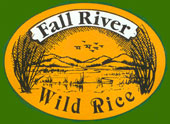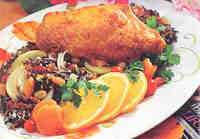
Wild Rice and Dried Fruit Pilaf
2 cups chicken broth
1 cup Fall River Wild Rice
1 Tablespoon butter
1 onion, sliced in thin wedges
2 teaspoons brown sugar, firmly packed
1/4 cup golden raisins
1/4 cup dried cranberries or cherries
1/4 cup dried apricots, chopped
1 teaspoon orange zest, grated
1 orange, juice only
1/4 teaspoon pepper
2 Tablespoons fresh parsley, chopped
Combine chicken broth and wild rice in medium saucepan; bring to boil. Reduce heat, cover and simmer 40 minutes or until almost tender. In small saucepan, melt butter over low heat, stir in onion and brown sugar. Cook ten minutes, stirring occasionally, until onion is tender and lightly browned. Add to rice the cooked onions, raisins, cranberries, apricots, orange zest, orange juice and pepper. Cover and simmer ten minutes or until rice is tender and grains have puffed open. Stir in parsley and serve warm.
Makes 6 servings
|
|
|
|
 |

Situated approximately 75 miles east of Redding California, the Fall River Valley is surrounded by Lassen, Shasta-Trinity and Modoc National Forests, Lassen Volcanic National Park, McArthur-Burney Falls Memorial and Ahjumawi Lava Springs State Parks and various Wildlife Refuges to the northwest. From its snow-capped heights, the majestic Mt. Shasta and Mt. Lassen tower over the region.
This is home territory to Walt Oilar who grew up in Cedarville, a town just east of the Warner Mountains. The Great Basin stretches off to the east into Nevada. His father was an agriculture teacher, and Walt studied agriculture business management at Chico State. “I didn’t like it much then,” he admits. “I would much rather have been out bird watching!”
But today Walt is the General Manager of Fall River wild Rice, a cooperative owned by 28 small wild rice growers. And he loves it. For starters, the view isn’t bad. “If I just get clear of a few big trees, I can see Mt. Shasta from here,” he says with obvious pleasure. “And just today my wife and I saw a group of bald eagles feeding in a field. There were a lot of cattle around, so I used them as cover and got within six to eight feet of them!”
Wild rice isn't literally a rice at all. It's the seed of Zizania palustris, a tall, blooming water grass that prospers in shallow lakes, marshes and streams, the only cereal grain native to the North American continent. It grows naturally in the Great Lakes region of Minnesota, but a California farmer in the early 80’s thought it would do well in the Fall River area. And he was right. Fertile soils, lush forests, clean air, spring waters, and a crisp climate make this an ideal mountain valley for producing wild rice.
Another interest of Walt’s is nutrition. Highly nutritious, wild rice contains more than 12% protein uncooked, significantly more than common white rice or most other grains. It is high in complex carbohydrates and is a good source of fiber. In contrast, its sodium content is refreshingly low.
Wild rice is easy to prepare; the longer it cooks, the softer and fluffier the grains become. Simmering in broth or wine gives wild rice a rich, full-bodied taste, and its flavor can be further enhanced by adding chopped vegetables, nuts or fruit. Uncooked wild rice will keep almost indefinitely, when stored in an airtight container. Cooked, it will keep for 10-14 days refrigerated, or can be frozen up to 6 months.
“What we call wild rice was a staple food of several Native American tribes,” Walt explains. “It was called "manoomin," which means "precious grain.” Wild rice remains "manoomin" for us because of its exquisite flavor.”
|
|
|
|




